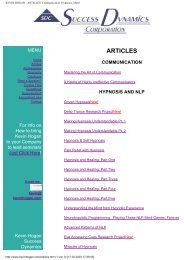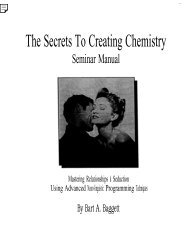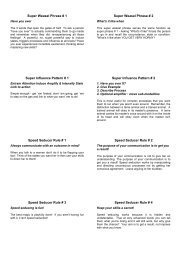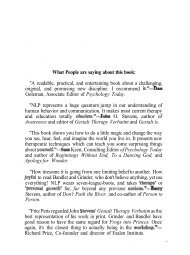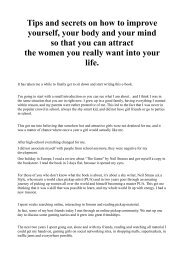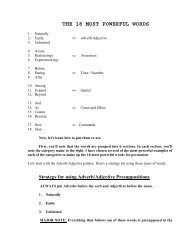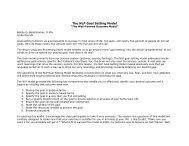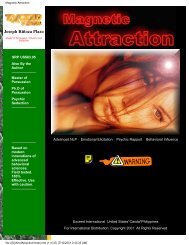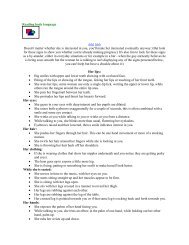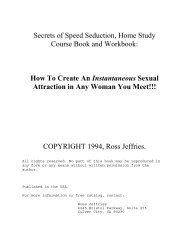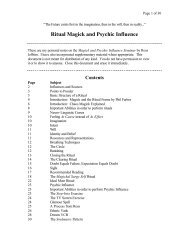A Pragmatic Guide To Communication & Change.pdf - NLP Info Centre
A Pragmatic Guide To Communication & Change.pdf - NLP Info Centre
A Pragmatic Guide To Communication & Change.pdf - NLP Info Centre
- No tags were found...
Create successful ePaper yourself
Turn your PDF publications into a flip-book with our unique Google optimized e-Paper software.
explore the function of the client's behavior not only within the family system but also<br />
with the therapists themselves. Through a process they call linguistic deconditioning,<br />
they began to change their perception of the client's behavior from one of being, as in<br />
"fie is (being) sad," to one of seerning or showing, as in "Hc is showing sadness," or<br />
"He seems sad."<br />
From this vantage point, it is much easier to observe the effects of the behavior rather<br />
than to dwell on the causes of the behavior. It can be much more useful to define the<br />
meaning of a behavior or communication by its ultimate effects on those around the<br />
communicator. This is especially important with some forms of analog communication.<br />
The Meta Model: Overview<br />
In 1975 Richard Bundler and John Grinder published a book which outlined their now<br />
popular Meta Model.' This is a linguistic (digital) tool which has proven extremely<br />
useful in therapeutic as well as other settings. It is based on the observation that human<br />
behavior, especially linguistic. I<br />
behavior, is rule-governed. The same processes of generalization, deletion, and<br />
distortion used in creating our models of reality are also used in the creation of our<br />
linguistic representation. of experience.<br />
As it is presented here, the Meta Model includes several distinctions not in the<br />
original, and the format has been altered. The basic assumptions still apply, however.<br />
Since it is a linguistic tool, the Meta Model relies on the natural intuitions of any native<br />
speaker of the English language.' In any communication, the spoken or written language,<br />
called the surface structure (SS), provides the listener with a rich variety of information<br />
about the speaker. It indicates how that person makes sense of the world, how he<br />
distorts his perceptions, and when and where those distortions occur Predicates, for<br />
example, may indicate his preferred represen<br />
7a<br />
tational system. The surface structure can also indicate when and what kinds of<br />
experiences the speaker systematically leaves out of his representation of the world. By<br />
assisting the speaker in "reconnecting" with the unspoken portion of his digital<br />
representation of experience, called the deep structure (DS), you begin a process of<br />
exploration. This process can fill in gaps of understanding that may occur between you<br />
and assist the speaker in recognizing and confronting limitations to growth and<br />
experience he may not even have known existed.<br />
Transformational Grammar<br />
A contemporary school of linguistics' , proposes a relationship between what is<br />
spoken or written by an individual and some deeper internal linguistic<br />
representation. The production of a sentence, the actual sound or written<br />
sequence of symbols and phrases, is called the surface structure (SS). The deep<br />
structure (DS) is also a system of symbols and phrases, but it is much more<br />
complex and abstract. The DS is the complete linguistic representation of a<br />
person's experience which might be considered the intent or the thought behind<br />
the SS sentence.<br />
The theory is that the DS is transformed into SS by a series of rules.<br />
Transformational grammarians say that the DS and the SS are related by certain<br />
formal operations which conform to the concepts of generalizations, deletion



